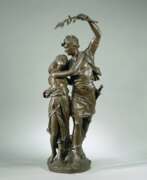Baroque Revival


Heinrich Baucke was a German sculptor renowned for his neo-baroque masterpieces, flourishing at the turn of the 20th century. Born in Düsseldorf on April 15, 1875, Baucke dedicated his life to the creation of statues and memorials that captured the nobility and distinguished figures of his time.
Trained at the Kunstakademie Düsseldorf under the tutelage of Karl Janssen from 1891 to 1900, Baucke's sculptures won him first prizes in competitions, solidifying his reputation as a preeminent artist. His works, primarily in bronze, are celebrated for their intricate detail and evocative presence. One of his earliest successes, "The Victorious Boxer" created in 1897, today stands in the Kunsthalle Düsseldorf, a testament to his skill and artistic vision.
Baucke's creations are not just pieces of art; they are historical dialogues in metal, with works like the bust of German Emperor Wilhelm I and the statue of King Friedrich I adorning public spaces, bridging the past with the present. His death on April 12 or 13, 1915, in Ratingen, marked the end of an era for German neo-baroque sculpture.
For collectors and art historians, Baucke's works offer a glimpse into the neo-baroque sensibilities of a bygone era. His sculptures, which often graced public spaces and exhibitions, now hold a place of honor in galleries and are sought after in auctions for their historical and artistic value.
Explore the legacy of Heinrich Baucke by signing up for our newsletter, and seize the opportunity to collect pieces from one of the neo-baroque's finest sculptors.


Reinhold Begas was a German sculptor of the second half of the 19th century. He is known as a representative of the neo-baroque style of the Berlin school of sculpture. Many of Begas' works still adorn squares in Berlin and other German cities today.
Reinhold Begas was the most famous representative of the family dynasty of painters and sculptors. His father Carl Joseph Begas, his brothers Carl Begas, Oskar Begas and Adalbert Begas and his eldest son Werner Begas all left their mark on German culture.
Reinhold Begas was one of the first professors at the Weimar School of Art. Until his death, the sculptor was a member of the Association of German Artists and a professor at the National Academy of Art.
During his lifetime, Begas created hundreds of works, including statues, busts, tombstones and bas-reliefs, but many of them were later destroyed during wars, revolutions and regime changes, including for political reasons.


Adelheid Dietrich was a German floral artist.
Adelheid Dietrich's paintings in the style of 17th century Dutch floral painting are remarkable for their extraordinary precision. She has exhibited her paintings in Dresden, Berlin, Bremen and Kassel.


Jef Lambeaux, full name Joseph Marie Thomas Lambeaux, was a Belgian sculptor who combined realism and the Renaissance.
Lambeaux studied at the Academy of Fine Arts in Antwerp and was a member of the Van Beers clique, a group of eccentric young artists that also included the artists Piet Verhart (1852-1908) and Alexander Streiss (1852-1941). He later became a founder of the Brussels-based avant-garde group Les Vingt.
Lambeaux's sculptures have often provoked mixed reactions, but they are a reinterpretation of Renaissance and Baroque body image. Turning to classical themes in depicting nudes in motion, Lambeaux created many fountain figures, park sculptures and monuments. Among them is the Brabo Fountain, which has become a landmark in Antwerp. For the 1897 World's Fair pavilion, he created a large-scale marble bas-relief "Temple of Human Passion", which was condemned by the Catholic Church for being a "marble brothel".
The sculptor was known for his love of competitive wrestlers and boxers, and adored circus performances. Scenes of struggle and love are a constant theme of Lambeaux's work. His sculpture "Wrestlers" is also inspired by the popular Renaissance theme of two naked bodies straining all their strength in an extreme struggle.
In 1903, Jef Lambeaux became a member of the Royal Belgian Academy.


François-Raoul Larche was a French Art Nouveau sculptor whose work included several figures of Christ, but who may be better known for his numerous female figures, both nude and draped.
He was one of several artists inspired by the dancer Loie Fuller; one of his best-known statues depicts Fuller dancing with part of her drapery billowing above and behind her head like a flame.


Hugo Lederer was a German sculptor and medallist. He lived and worked in Berlin during the reign of Kaiser Wilhelm II and the first German democracy. His most famous work is the monumental monument to Bismarck in Hamburg (1902-1906).
Hugo Lederer always stood on the side of upper-class modernism and opposed the anti-bourgeois left-wing or popular art scene. Initially he was still following Reinhold Begas and his neo-Baroque style, the Gründerzeit art movement favoured by Kaiser Wilhelm II and despised by many intellectuals of the time.


Margaretha Roosenboom was a 19th-century Dutch floral artist. She studied painting under her father, Nicolaas Johannes Roosenboom.
Margaretha Roosenboom mainly painted still lifes, both with flowers and fruit. In particular, roses were the central theme of her works.


Walter Schott was a German sculptor and medalist, a representative of the neo-Baroque school of sculpture in Berlin.
Schott studied at the Berlin Academy and is the author of many sculptures for public spaces. His best-known work is "The Butcher Woman," executed in 1897 in life-size bronze for the flower garden at the southern end of the Königsallee in Düsseldorf.































